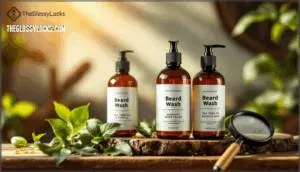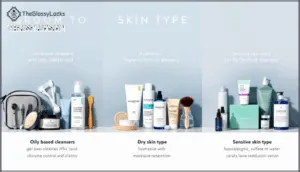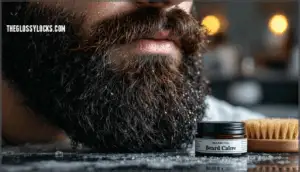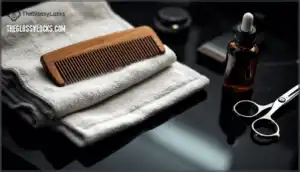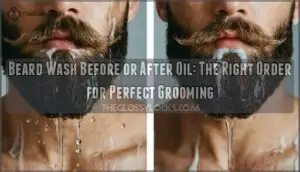This site is supported by our readers. We may earn a commission, at no cost to you, if you purchase through links.
 Your beard shields your face from up to 95% of UV rays and cuts bacterial skin problems by over 40%, but these benefits vanish without consistent care.
Your beard shields your face from up to 95% of UV rays and cuts bacterial skin problems by over 40%, but these benefits vanish without consistent care.
A proper beard care routine isn’t just about looking sharp—it’s about protecting your skin, preventing irritation, and building the kind of confidence that comes from feeling your best.
The right combination of washing, moisturizing, and trimming transforms your beard from a potential source of discomfort into a healthy part of your appearance that works for you every day.
Table Of Contents
Key Takeaways
- Your beard blocks up to 95% of UV rays and reduces bacterial skin problems by over 40%, but these benefits only last if you maintain a consistent washing, moisturizing, and trimming routine.
- Washing your beard 2-3 times weekly with sulfate-free products prevents dryness while removing buildup, though you’ll need to adjust frequency based on your skin type—oily skin may need daily washing while dry skin does better every 2-3 days.
- Daily moisturizing with beard oils and balms within three minutes of washing locks in hydration and reduces irritation by up to 45%, transforming brittle facial hair into soft, manageable growth.
- Regular trimming every 2-8 weeks depending on beard length prevents split ends and irritation while maintaining shape, but you’ll need to balance the time commitment of 10-20 minutes daily and potential costs of $700-1,200 annually for professional care.
Why is a Beard Care Routine Essential?
Your beard isn’t just facial hair—it’s a reflection of your health, comfort, and confidence. A solid care routine protects your skin, prevents irritation, and helps you feel good about how you look.
Let’s explore why grooming matters for both your physical well-being and self-image.
Health Benefits of Regular Beard Grooming
Your beard can be a major plus for your overall health and appearance. Regular beard grooming delivers real benefits you can feel and see:
- Beard health starts with skin health. Proper care blocks up to 95% of harmful UV rays, protecting your face from sun damage and aging.
- Infection prevention matters. Clean beards reduce bacterial colonization, lowering your risk of folliculitis and skin irritation by over 40%.
- Skin hydration improves naturally. Moisturizing products boost water retention by 20%, preventing dryness and flakiness under your beard.
- Mental well-being gets a boost. Men with groomed beards report 30% higher confidence and reduced stress through consistent self-care routines.
A healthy routine also makes for better beard growth.
Impact on Skin Health and Comfort
Your skin’s comfort depends on what’s happening under your beard. Without proper care, you face real problems: 47% of men experience dryness without moisturizing, leading to itchiness and dandruff. Shaving irritation hits up to 40% of people with curly hair, causing razor burn and follicular problems.
Good beard care reduces flaking by 37% and cuts breakouts by 23%. Your beard also shields skin—blocking 95% of UV rays and maintaining microbial balance. However, it’s important to remember that facial hair can also hide potential skin cancers.
Proper hydration prevents split ends in 32% of cases, while regular washing drops infection risk by 86%. Sensitive skin especially benefits from this protection.
Boosting Confidence and Self-Expression
Beyond skin health, your grooming habits shape how you see yourself. 75% of men feel more confident with facial hair, and maintaining your beard style reinforces that boost.
Regular beard care isn’t just about facial appearance—it’s expressing individuality and cultural identity. Beard styling becomes self-expression: 48% view it as personal art.
Your beard identity signals maturity and assertiveness, affecting social perceptions. Confidence grooming reduces anxiety by 20–35%, turning routine maintenance into emotional self-care. Beard self-esteem grows when your beard appearance aligns with who you are.
A well-groomed beard signals maturity and confidence, reducing anxiety by up to 35% through consistent self-care that aligns your appearance with your identity
How Does Proper Washing Affect Beard Health?
Washing your beard the right way makes a real difference in how it looks and feels. The frequency, products, and methods you choose all depend on your unique skin type and beard texture.
Let’s break down the key factors that help keep your beard clean without causing dryness or irritation.
Recommended Beard Washing Frequency
How often should you cleanse your facial hair? Most grooming experts recommend washing your beard 2-3 times per week to maintain cleanliness without stripping natural oils. Your skin type matters—oily skin may need daily beard washing, while dry skin does better with every 2-3 days.
Lifestyle factors like exercise and pollution exposure can increase washing frequency to 3-4 times weekly. Over-washing risks dryness and beardruff, so adjust your beard care routine based on beard length and how your skin responds.
Choosing The Right Beard Wash
What determines the best beard wash for your unique needs? Selecting sulfate-free beard washes with pH balance between 4.7 and 5.7 protects your skin’s natural barrier and reduces irritation by up to 25%. Here’s what to prioritize:
- Ingredient transparency matters—look for natural oils like jojoba and argan, which boost moisture retention by 22% and soften beard hair by 40%.
- Dermatological benefits count—tea tree oil fights 90% of beard bacteria, while salicylic acid reduces ingrown hairs by 25%.
- Market trends favor clean formulas—64% of buyers now choose beard care products based on natural ingredients over brand names.
Non-comedogenic beard cleansing products prevent clogged pores by 50%, keeping your skin healthy beneath facial hair.
Adapting Washing to Skin Type
Your skin type shapes how often you should wash your beard and what products work best. Oily skin thrives with gel-based cleansers containing salicylic acid, used four to five times weekly to control sebum and prevent clogged pores.
Dry skin needs hydrating, fragrance-free formulas with glycerin or aloe vera, limiting washing to two or three times per week to preserve moisture.
Sensitive skin requires hypoallergenic, sulfate-free products and lukewarm water to minimize irritation and redness.
What Role Does Moisturizing Play in Beard Care?
Think of moisturizing as the shield that keeps your beard soft and your skin underneath healthy. Without it, you’re setting yourself up for itchiness, flaking, and a beard that feels more like steel wool than facial hair.
Here’s what you need to know about keeping everything hydrated and comfortable.
Benefits of Beard Oils and Balms
Think of beard oils and balms as nourishment for your facial hair and the skin beneath it. These products provide deep hydration that prevents dryness and brittleness, while ingredients like argan and jojoba oil mimic your skin’s natural oils. Regular use can boost beard thickness by 18% and reduce irritation by 45%.
Beard balms offer extra styling control and environmental protection, shielding your beard from wind and UV damage. Together, they’re essential tools in your beard care routine for achieving softness, texture enhancement, and even growth stimulation.
Daily Moisturizing Techniques
The secret to unlocking your beard’s full potential lies in consistent daily beard care practices. Follow these four beard moisturizing methods to combat beard dryness effectively:
- Application Timing: Apply beard oil within three minutes after washing to get the most out of skin hydration and lock moisture into hair shafts.
- Product Layering: Use oil first for hydration, then balm to seal it in—this reduces water loss by 20%.
- Tool Use: Distribute products evenly with a comb or brush to prevent clumping and boost absorption by 15%.
- Frequency Response: Moisturize twice daily to maintain ideal hydration levels and reduce irritation by 40%.
This moisturizing and conditioning beard routine transforms dry, brittle facial hair into soft, manageable growth.
Product Selection for Different Skin Types
Choosing the right beard products starts with understanding your skin type. For dry skin, argan or jojoba oils boost hydration by 35%, while shea butter balms work best.
Oily skin needs lightweight, non-comedogenic options like hempseed oil to prevent clogged pores.
Sensitive skin thrives with fragrance-free formulas containing chamomile, reducing irritation by 35%.
Combination skin benefits from dual-action products that balance moisture across different zones, cutting greasiness by 20%.
How Does Trimming and Maintenance Improve Your Beard?
Trimming isn’t just about looking sharp—it’s the key to keeping your beard healthy and comfortable. Regular maintenance prevents common problems like split ends, irritation, and uneven growth that can sabotage your grooming goals.
Here’s what you need to know about creating a trimming schedule and choosing the right tools for your beard.
Trimming Schedules for Growth Vs. Maintenance
Your beard’s growth stage shapes how you trim. During the first 4–6 weeks, focus on shaping necklines and cheek lines—not length—to let follicles establish even density. Once established, switch to maintenance trimming.
Medium-length beards need trims every 2–4 weeks, long beards every 6–8 weeks, and short styles every 7–10 days. Your beard trimming techniques depend on beard length, growth rate, and the beard shape you want.
Proper trimming tools and awareness of trimming factors like climate and hair density help you adjust schedules for best comparative impacts on health and appearance.
Preventing Split Ends and Irritation
Split ends and skin irritation aren’t just cosmetic issues—they signal deeper damage. When your beard’s protective cuticle breaks down, fibers fracture and weaken, causing itchiness and discomfort beneath the surface.
Hydration strategies and trimming techniques work together to stop this cycle:
- Trim every 4–6 weeks to remove damaged tips before splits travel up the strand
- Apply beard oils daily after washing to restore lipid protection and reduce friction-induced inflammation
- Shield from environmental factors like UV exposure and cold, which increase brittleness by up to 40%
- Check product ingredients carefully—alcohol-based formulas strip natural oils and accelerate keratin breakdown
Lifestyle influences matter too. Poor hydration and stress reduce your skin’s natural lubrication, making beard conditioning essential for long-term softness and comfort.
Essential Tools for Effective Grooming
Your grooming tools determine your results. You’ll need a quality trimmer with self-sharpening blades, a boar-bristle beard brush for oil distribution, and a wide-tooth beard comb for detangling. Ergonomic design reduces hand strain during sessions.
Store everything in a kit to prevent bacteria buildup and maintain blade sharpness—proper tool maintenance extends lifespan by 40% and keeps your beard looking sharp.
What Are The Trade-Offs in Beard Care Routines?
A solid beard care routine brings real benefits, but it also comes with trade-offs you’ll want to keep in mind. You’ll need to balance time commitments, budget constraints, and your skin’s unique needs.
Let’s look at three key areas where these decisions play out in your daily grooming.
Time and Cost Considerations
How much time and money does maintaining your beard really take? Your grooming routine demands a realistic look at both. Daily beard care generally requires 10 to 20 minutes, while weekly trimming adds another 15 to 30 minutes. Understanding these trade-offs helps you build sustainable grooming habits that fit your lifestyle.
- Professional salon expenses range from $15 to $80 per trim, totaling $700 to $1,200 annually
- At-home product costs average $26 to $100 monthly for quality beard grooming tools and supplies
- Consistent home grooming routines boost routine efficiency and cut professional visits by 35 to 50 percent
- Investing in reusable grooming tools delivers long-term savings compared to recurring salon fees
- Subscription services reduce beard care product expenses by 10 to 20 percent through bulk purchasing
Product Choice and Skin Sensitivity
Your choice of beard care products directly affects your skin’s response. Product selection demands attention to ingredient sensitivities, especially when 45 to 60 percent of users experience sensitivity reactions to synthetic ingredients. Hypoallergenic benefits matter—studies show these formulations reduce irritation by 52 percent within four weeks. Natural ingredients like argan oil maintain 80 percent higher hydration, while dermatological risks from parabens and sulfates can strip 40 percent of your skin’s protective oils.
| Product Type | Skin Sensitivity Impact |
|---|---|
| Synthetic fragrances | 70% of irritation cases reported |
| Organic formulations | 68% reduction in redness observed |
| Alcohol-based products | 28% increase in skin barrier breakdown |
| Hypoallergenic options | 52% fewer irritation incidents |
Consumer awareness drives better outcomes—81 percent now seek non-toxic, cruelty-free beard products for healthier results.
Building a Consistent Routine for Lasting Results
Your daily beard care commitment shapes long-term sustainability and skin health outcomes. Structured routine adherence drives measured results—83 percent of users following consistent beard grooming routines report fewer ingrown hairs and breakouts after eight weeks. Stepwise consistency transforms your beard:
- Cleanse 2-3 times weekly with beard-specific products for prime skin balance
- Moisturize daily to restore elasticity in 66 percent of participants
- Brush each morning to boost natural shine by 48 percent
- Trim every 1-2 weeks to reduce split ends by 49 percent
Fixed beard care routine steps increase adherence by 63 percent over generic approaches.
Frequently Asked Questions (FAQs)
How often should you replace beard grooming tools?
You should replace trimmer blades every 3-6 months and swap your beard brush annually. Electric trimmer heads need changing when you notice material degradation or dullness.
Blade sharpness affects cut quality, while hygiene concerns and usage frequency determine replacement timing. Storage impacts tool longevity too.
What ingredients should you avoid in beard products?
Steer clear of harsh sulfates, drying alcohols like isopropyl, artificial dyes, overpowering fragrances, and pore-clogging oils.
Your skin health depends on natural ingredients that won’t trigger beard concerns or sensitivity in beard care products.
How does climate affect your beard care needs?
Cold winters dry out your beard and skin, so you’ll need richer beard oils and balms. Hot, humid climates require lighter products to prevent greasiness. Sun exposure calls for extra moisturizing and protection.
Adjust your beard care and trimming schedule as seasons shift to maintain proper skin hydration and beard maintenance year-round.
When should you seek professional barber help?
Sometimes shaping complexity or sophisticated styling demands expertise beyond your bathroom mirror.
Seek professional barber help for special events requiring precise beard trimming techniques, when learning proper tool education, or if your beard style and face shape aren’t aligning despite your best efforts at beard shaping.
Conclusion
Your beard is like a garden—it only thrives when you tend to it with care. The importance of a beard care routine shows up in every mirror check, every comfortable day, and every moment you feel proud of how you look.
Washing removes buildup, moisturizing prevents dryness, and trimming keeps everything sharp. These aren’t optional steps—they’re the foundation of healthy skin and lasting confidence.
Commit to the routine, and your beard becomes an asset that works for you daily.
- https://www.gminsights.com/industry-analysis/beard-grooming-products-market
- https://www.futuremarketinsights.com/reports/beard-grooming-products-market
- https://www.mordorintelligence.com/industry-reports/beard-care-products-market
- https://blog.massgeneralbrighamhealthplan.org/the-health-benefits-of-facial-hair-a-unique-shield-for-your-skin
- https://fivestarbarberbrand.com/2025/08/02/the-health-benefits-of-growing-a-beard/


